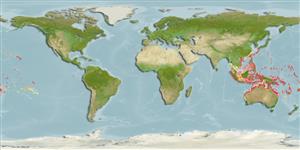>
Eupercaria/misc (Various families in series Eupercaria) >
Lethrinidae (Emperors or scavengers) > Lethrininae
Etymology: Lethrinus: Greek, lethrinia, a fish pertaining to genus Pagellus.
Eponymy: William Sackston Atkinson (1864–c. [...] (Ref. 128868), visit book page.
More on author: Seale.
Environment: milieu / climate zone / rango de profundidad / distribution range
Ecología
marino asociado a arrecife; no migratorio; rango de profundidad 2 - 30 m (Ref. 2295), usually 2 - 18 m (Ref. 37816). Tropical; 31°N - 32°S, 96°E - 134°W
Pacific Ocean: Indonesia and Philippines, north to southern Japan, south to Australia, east to the Tuamoto Islands. Has most frequently been named Lethrinus mahsena.
Length at first maturity / Tamaño / Peso / Age
Madurez: Lm ?, range 28 - ? cm
Max length : 50.0 cm TL macho / no sexado; (Ref. 48635); common length : 32.5 cm TL macho / no sexado; (Ref. 2295); edad máxima reportada: 24 años (Ref. 2290)
Espinas dorsales (total) : 10; Radios blandos dorsales (total) : 9; Espinas anales: 3; Radios blandos anales: 8.
Body shape (shape guide): fusiform / normal; Cross section: oval.
Inhabits seagrass beds and sandy areas of lagoons and outer reef slopes. Found singly or in schools. Feeds mainly on crustaceans, mollusks, and fish. Marketed fresh (Ref. 9775).
Life cycle and mating behavior
Madurez | Reproducción | Puesta | Huevos | Fecundidad | Larva
Gonochorism is inferred for this species as sizes of males and females overlapped and male gonad morphology is typical of secondarily derived testes (Ref. 103751). Juvenile hermaphroditism is exhibited by this species (Ref. 35994).
Carpenter, K.E. and G.R. Allen, 1989. FAO Species Catalogue. Vol. 9. Emperor fishes and large-eye breams of the world (family Lethrinidae). An annotated and illustrated catalogue of lethrinid species known to date. FAO Fish. Synop. 125(9):118 p. Rome: FAO. (Ref. 2295)
IUCN Red List Status (Ref. 130435: Version 2025-1)
Threat to humans
Harmless
Human uses
Pesquerías: escaso valor comercial; pesca deportiva: si
Herramientas
Special reports
Download XML
Fuentes de Internet
Estimates based on models
Preferred temperature (Referencia
123201): 25.1 - 29.3, mean 28.6 °C (based on 2744 cells).
Phylogenetic diversity index (Referencia
82804): PD
50 = 0.5000 [Uniqueness, from 0.5 = low to 2.0 = high].
Bayesian length-weight: a=0.01585 (0.01032 - 0.02433), b=3.00 (2.88 - 3.12), in cm total length, based on LWR estimates for this species & Genus-body shape (Ref.
93245).
Nivel trófico (Referencia
69278): 3.8 ±0.0 se; based on diet studies.
Resiliencia (Referencia
120179): Medio, población duplicada en un tiempo mínimo de 1.4-4.4 años (K=0.29-0.31; tm=3.7-5; tmax=24).
Prior r = 0.49, 95% CL = 0.33 - 0.74, Based on 1 data-limited stock assessment.
Fishing Vulnerability (Ref.
59153): Moderate vulnerability (35 of 100).
🛈
Nutrients (Ref.
124155): Calcium = 44.1 [31.1, 63.0] mg/100g; Iron = 0.829 [0.557, 1.158] mg/100g; Protein = 20.3 [17.7, 22.5] %; Omega3 = 0.123 [0.088, 0.169] g/100g; Selenium = 37.1 [20.8, 58.2] μg/100g; VitaminA = 30.9 [6.9, 161.8] μg/100g; Zinc = 2.07 [1.59, 2.64] mg/100g (wet weight);
